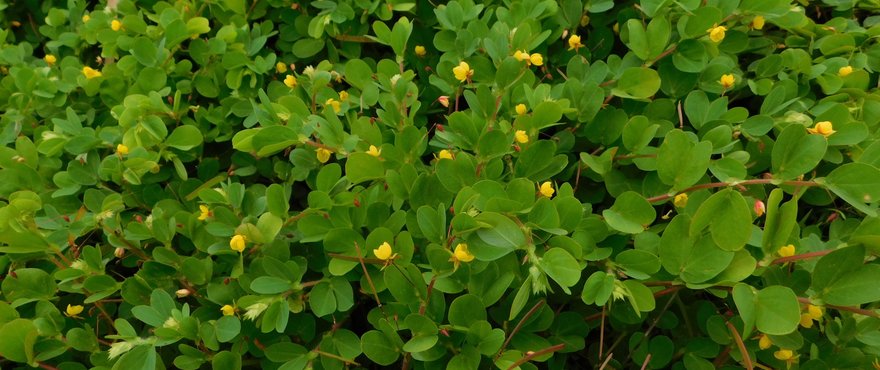Download a copy of the Wynn cassia factsheet.
Round leafed cassia is a legume, native to savanna and similar vegetation zones in tropical and sub tropical North and South America. After field testing in central and southern Queensland, comparing a range of types, one line was selected for its overall superior performance and registered as cultivar Wynn. Wynn cassia is a short-lived perennial whose growth habit varies with stand density and grazing pressure. In open stands, ungrazed plants are low and sprawling, growing to about 30cm high and a metre across. In dense stands, plants are more upright and less branched growing to over 50cm high. Under heavy grazing, plants take on a flattened rosette form. The small yellow flowers produced along the stem give rise to thin pods about 5mm wide and 40mm long which bear the light brown seeds. Wynn cassia is seen mainly as a supplement to native pastures more than as a companion legume for more aggressive improved grasses such as Rhodes grass and Green panic. It is a useful addition to Fine stem stylo, in low key improvement of native pastures. Wynn cassia grows as a perennial in a 900–1500mm rainfall region, and as an annual in a 400–900mm region. It prefers free-draining light soils of acid to neutral pH, particularly sands or sandy loams of low to moderate fertility. This variety is summer growing. Although tops are burnt by frost, Wynn cassia can be planted in frosted areas, because roots and crowns survive all but the most severe frost. Plants regrow quickly with spring rains.
Key features
- Non-bloating, free seeding, self regenerating annual
- High seed yield
Key benefit
- Adapted to low fertility and acid soils
Agronomy and management
Wynn cassia is very tolerant of and requires constant heavy grazing. If allowed to grow tall and then ‘crash’ grazed, individual plants fail to regenerate and die. Populations will regenerate from seed. Not selectively grazed in the young, growing stages but preferred when the leaves are older, often after seed set or frosting.
Inoculation
Group M; promiscuous but inoculation is recommended.
Fertiliser
Responds to phosphorus and sulphur on soils of low-fertility (based on soil test).
Seed production
Very heavy seed set, but seed ripens over an extended period and shatters. Ability to spread Will spread naturally through seed shattering and in dung after ingestion by livestock.
Establishment
All legumes establish better on prepared seedbeds, however this is not always achievable, particularly when planting into uncleared or partly cleared country. Wynn can be established successfully when broadcast after a burn or onto ploughed strips through native pasture. With strip plantings, Wynn spreads rapidly into undisturbed land between the strips.
Wynn cassia often has a high proportion of hard seed which can lead to poor initial stands unless seed is scarified. Mechanical scarification or dry heat treatment gives best results. Hot water treatment should not be used as the seeds will stick together. Wynn nodulates freely with native rhizobia, however inoculation with cowpea strain rhizobium is recommended.
Mo superphosphate at planting is generally adequate or molybdenum trioxide is applied to AgriCOTE Enhanced Seed, as Wynn has been shown to give good response to molybdenum.
Animal production
Feeding value
Good protein and digestibility levels recorded under grazing on fertile soils. Application of P and S on low fertility soils increased N concentrations of leaf tips to 3.3% N (21% crude protein). Wynn cassia has raised the N concentration of black spear grass by 20–40% under grazing and fertilising (with P & S).
Palatability
Generally not readily eaten by cattle in the growing season under higher rainfall conditions, but becomes more acceptable as the associated grasses mature later in the season. Can comprise up to 20% of the diet in late autumn. Lower seasonal palatability differential in drier areas as plant tissue is generally drier. Not eaten by horses.
Production potential
DM yields of up to 7000kg/ha recorded but less in drier environments.
Livestock disorders/toxicity
No known anti-nutritional factors.
Suggested sowing rates
Recommended planting rates for AgriCOTE Pro-Tech oversow for Wynn cassia are:
Alone: 3kg per hectare
In mix: 2–5kg per hectare
Irrigated: 8–10kg per hectare Sow in spring/summer.
Disclaimer: The information presented in this brochure is from official and other sources and is considered to be reliable. It is provided in good faith and every care has been taken to ensure its accuracy. Barenbrug does not accept any responsibility for the consequences that may arise from the acceptance of recommendations or the suggestions made.


